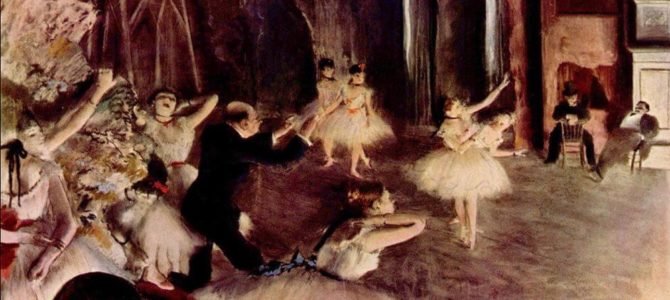
Edgar Degas (1834-1917) is one of the most popular of all the French Impressionists, and particularly well-known for his many pretty images of ballet dancers. A new exhibition of his work, “Degas at the Opéra,” which opened recently at the National Gallery of Art in Washington, D.C., had to be temporarily closed due to the Wuhan virus outbreak, but not before I got the chance to see it.
I went expecting to see a lot of ballerina paintings, images I was conscious of mostly as posters and postcards hung on the dormitory walls of seemingly every other girl I knew at college. To my surprise, what I found was not only far more complex than I had anticipated, but also challenging to my preconceptions of Degas as little more than the Maurice Chevalier of painters.
With around 100 works distributed among eight galleries, once it reopens to the public visitors will appreciate the fact that this is quite a large show, exploring Degas’s interest in, and relationship to, the Paris Opéra. That includes the dancers, of course, but also musicians, composers, patrons, instructors, and others Degas observed in the center of the performing arts world at the time.
Edgar Degas At the Orchestra
Throughout the NGA show, video screens playing opera excerpts provide visitors the opportunity to hear what Degas would have been listening to at one of the performances, even if the artist took some liberties with how he chose to depict those performances on canvas. In “The Orchestra of the Opera” (1870) for example, the focal point of the picture is the portrait of a bassoonist friend of the artist, even though an informed observer would know that a bassoonist doesn’t normally sit so close to the front in an orchestra pit.

The painting is also an early example of how Degas took keen advantage of the unusual sight lines afforded him from where he sat, to come up with interesting compositions from unusual vantage points. Because women were not allowed to sit downstairs near the orchestra, for example, if he was seated in a box Degas might find himself behind a group of them watching a performance, such as in “Theater Box” (1885) from the Hammer Museum. Here the lady in the foreground and the figures in the background combine to overwhelm the visible space.
By contrast, in “Study of a Theatre Box” (1880) from the Museum of Fine Arts in Houston, the space overwhelms the figure, since the lady watching can barely be seen over the heavy architecture of the box.

Among the most unusual works in the show are examples of exactly the sort of thing ladies would take to the opera. The exhibition features a group of painted fans by Degas, which line a long wall in one of the galleries. Most depict dancers, and among the more unusual objects is one featuring several Spanish couples singing and dancing. Degas gave it as a gift to fellow Impressionist Berthe Morisot (1841-1895), whom was recently the subject of a first-ever solo show in America.
Plenty of Ballet Images, Of Course
In addition to pictures of musicians, singers, and patrons, Degas lovers can rejoice, for there are plenty of ballet images in this exhibition, from drawings and sketches to pastels and oil paintings. The Musée d’Orsay’s famous “The Ballet Class” (1871-74) is here, featuring ballet teacher Jules Perrot standing in the middle of a room. It was Degas’ idealized reconstruction of a space in the demolished old opera house, surrounded by a sea of fluttering activity.
Here, too, is the National Gallery’s popular “Four Dancers” (1891), in which the young women seem to melt into the colored gels of the footlights, almost anticipating Secessionism. There are even dance scenes from operas themselves, such as the Metropolitan Museum of Art’s “The Ballet from ‘Robert le Diable’” (1871), in which a group of ghostly nuns rise from the dead.


Notice how the bearded man in the center of the picture is not even watching what’s happening on stage. He has his opera glasses out, and he’s looking at someone or something else, over to his left. Admittedly, the opera house was well-known as a place one could go to make romantic liaisons, but there was also a seedier side to going to the opera, of which Degas seems to have become increasingly aware the more he visited. Once you get past the ribbons, the tutus, and the bright colors of the dancers, there are sometimes sinister undertones in Degas’ depictions of backstage life.
Take “Ballet Rehearsal on Stage” (1874), on loan from the Musée d’Orsay, or the National Gallery’s own “The Curtain” (1880). Why are these older men in dark coats and hats hanging about backstage, staring at or trying to interact with very young girls?


Even more obviously, why are several of the “admirers” in “Virginie Being Admired While the Marquis de Cavalcanti Looks On” (1876-1877) staring at the performer’s posterior? We all know the answer, of course, because very little has changed in the entertainment world.

The backstage habitués who appear as shadowy figures in Degas’s work were likely men of means and influence for them to gain such a level of access. Their presence is a manifestation of the all-too-familiar tale of starry-eyed young performers being promised the world by predators. The smarter girls might get lucky, and convince one of these men to marry them or set them up in luxury. More often than not, however, these little dancers were just disposable playthings, pimped out by their parents, landlady, or even other dancers who had been treated in the same way.
A Sad Backstory to a Famous Degas Piece
A rather sad example of what happened to most of these young girls can be found in the backstory of the culminating piece of the NGA show, which is also one of Degas’ greatest masterpieces.
“Little Dancer Aged Fourteen” (1878-81) is an unusual sculpture, composed of wax, cloth, human hair, and other materials, somewhat like a secular version of the hyper-realistic religious sculptures of Spain and Italy. It portrays Belgian-born Marie van Goethem, a member of the ballet corps at the Paris Opéra, whom Degas depicted several times in his art.

Marie’s family had moved into one of the worst neighborhoods in Paris, and like many of her fellow dancers, no doubt she saw the bright lights of the stage as a way to pull herself and her family up out of the gutter. At around the time Degas completed his sculpture of her, Marie finished her training, and became a full-time member of the troupe.
Unfortunately, by 1882 Marie was caught frequenting some of the seediest bars in Paris, and after missing too many rehearsals was dismissed from the Opéra: she was only 17 years old. No one knows what happened to her after that, since other than Degas’ interest in portraying her, she was just one of a countless number of dancers who disappeared into oblivion.
As exhibition curator Kimberly A. Jones pointed out during the press conference, Marie achieved a kind of immortality through Degas’s art she could never have achieved on the stage. Yet I wonder whether, in the end, it was worth it.
More than a Sentimental Painter
One of the marks of a good exhibition is not only that it sticks with you, but that it forces you to reexamine your preconceived ideas. In this show, I have to recognize that I was wrong. I dismissed Degas for many years as a decorative, sentimental painter; I didn’t take the time to really look into both the art and the subject matter of his pictures, beyond what was apparent on the surface.
There was clearly far more going on in the working mind of this artist than just the execution of the ubiquitous, pretty pictures of ballerinas with which we’re all familiar, and in admitting my ignorance I’m also pleased to have the opportunity to learn more. That, in turn, is the mark of a great exhibition.
Until this show reopens to the public, there are some online resources for those who want to learn more. The NGA has provided a multi-part audio tour, featuring 21 of the objects in the exhibition with accompanying images, which you can listen to here. There is also a text and image-based presentation on Degas and his relationship to the Paris Opéra here. On the National Gallery’s YouTube channel, you can catch a full slideshow lecture on “Degas at the Opéra.”
“Degas at the Opéra” is scheduled to be at the National Gallery of Art in Washington through July 5; check with the museum for details on when the show will reopen.









